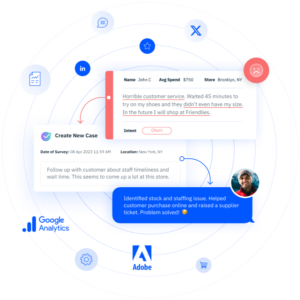How to Achieve Versatile, Modernized Listening Within CX
Long-winded surveys, question inundation, and collecting only explicitly solicited feedback have long been norms in the customer experience (CX) world, but today’s brands need something more versatile if they hope to keep up with their customers.
Whether your brand is emerging from the COVID-19 pandemic or searching for new groups of customers, it’s become clear that traditional methods of listening don’t quite cut it for learning what customers want anymore. Long-winded surveys, question inundation, and collecting only explicitly solicited feedback have long been norms in the customer experience (CX) world, but today’s brands need something more versatile if they hope to keep up with their customers.
What follows is a brief discussion of four ways to transition to versatile, modernized listening within CX:
- Long-Form Surveys Versus Multimedia Feedback Options
- Single-Point Versus Multi-Point Feedback
- Spray-and-Pray Approach Versus Optimized Surveys
- Solicited Feedback Versus Unsolicited Feedback
Long-Form Surveys Versus Multimedia Feedback Options
The long-form survey has been the traditional customer experience questionnaire for many years. Multiple brands rely on these surveys to gather feedback from customers and sometimes build their entire CX strategies around them, too. Typically, a long-form survey comes packed with questions aimed at every possible facet of the customer experience.
Ostensibly, these surveys’ goal is to gather detailed, actionable insights from customers, but their format leaves a lot to be desired. For a start, the sheer length of long-form surveys makes them unattractive to many customers, meaning that this questionnaire is often dead at the starting gate. Traditional surveys may also come packed with questions that many customers find irrelevant. Finally, long-form surveys tend to focus on what brands consider to be important, not what customers do.
Instead of throwing long-winded surveys at customers, brands should instead opt for multimedia feedback options. Multimedia feedback options kill several birds with one stone—they enable customers to express their opinions in a format they prefer (be it audio, video or other), allow brands to learn what customers consider important, and take up much less bandwidth than reams of formal questions.
Because of this, brands should do away with long-form surveys in favor of multimedia feedback options. It makes for a more versatile, more engaging solution that can better enable organizations to acquire the feedback they need to achieve meaningful change.
Single-Point Versus Multi-Point Feedback
Another strategy that has traditionally defined customer feedback efforts is restricting insights collection to a single point on the customer journey. Many brands save gathering feedback for the end of a transaction or another singular point.
The drawback with this strategy is that the customer journey doesn’t consist of a single point. It’s a multi-point, multi-channel endeavor that varies endlessly between different organizations. As such, brands can intensify their feedback collection by posting feedback options at every step of the customer journey.
When brands engage in a multi-point, multi-channel feedback strategy, they gain a holistic understanding of the customer journey that cannot be acquired via studying a single point on that journey. Focusing on a single touchpoint can skew a brand’s view of that journey and lead them to indirect conclusions. Multi-point feedback, by contrast, can give brands the full picture and thus a much better idea of what on their customer journey may need improvement.
Spray-and-Pray Approach Versus Optimized Surveys
In addition to making their surveys very lengthy, many organizations aren’t shy about inundating customers with multiple long-form questionnaires. This strategy may be intended to boost brands’ chance of receiving feedback, but all it oftentimes accomplishes is leaving customers overwhelmed and unwilling to complete any surveys, never mind all of them.
Optimized surveys are just as important to gathering accurate, actionable feedback as keeping questionnaires short or posting them at every stage of the customer journey. Optimizing surveys means posting them at whichever touchpoints customers are at, especially if they leave the journey at one given point or another. Rather than drown customers in surveys, organizations can boost the chance that their survey will be completed at all by posting it at the touchpoint most relevant to the customer in that moment.
This strategy helps customers feel that brands are truly interested in what those individuals have to say. Optimizing surveys for touchpoints and feedback options also encourages customers to speak up because, as we discussed with those aforementioned options, it provides a great platform for them to speak what’s on their minds.
Solicited Feedback Versus Unsolicited Feedback
We’ve mentioned a few times now that brands traditionally load questionnaires and other feedback methods with the topics that they’re interested in. While important, this interest doesn’t always line up with what customers are interested in, and what customers are interested in can make or break an experience improvement effort.
Along those same lines, brands oftentimes prefer to focus on gathering solicited feedback from preselected groups of customers. The catch with this approach is that, much like gathering insights from a single point on the customer journey, collecting feedback from one predetermined group of people risks giving organizations a skewed view of what their customers actually want.
To gain a better understanding of their experience and what customers seek from them, companies should also strive to gather unsolicited feedback from not just customers but also brand advocates, brand detractors, and non-buyers. These groups’ opinions are just as important to understanding perception of a brand as customer perspectives, and can help companies gain that aforementioned, holistic understanding just like multi-channel feedback options.
In CX, Versatility is King
The common theme with all of these feedback strategies is versatility. Brands that that let customers express themselves in their own terms at whichever point of the experience journey they’re on will gather far more valuable feedback than organizations that don’t allow that versatility for themselves.
Organizations can further enrich this feedback by gathering insights from any groups that interact with them, not just preferred pools of customers. By succinctly gathering information in a way that espouses context, organizations can gather the actionable insights they need to ascend their marketplace and, ultimately, create a better experience for their customers.
Interested in learning more about achieving modern, versatile feedback? Check out our webinar, “The Future of Feedback: Adapting Customer Listening for Our Changing World” here.

